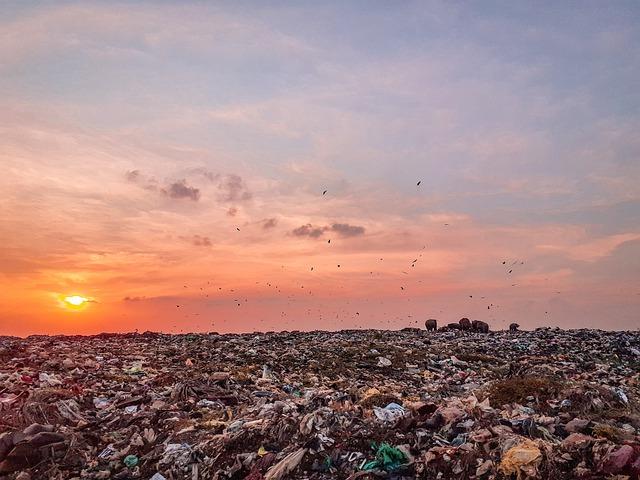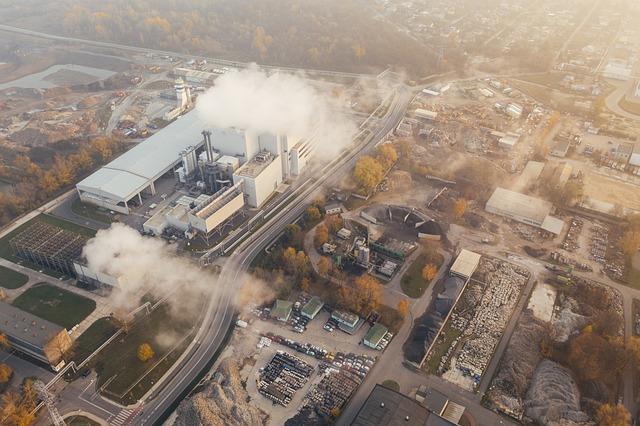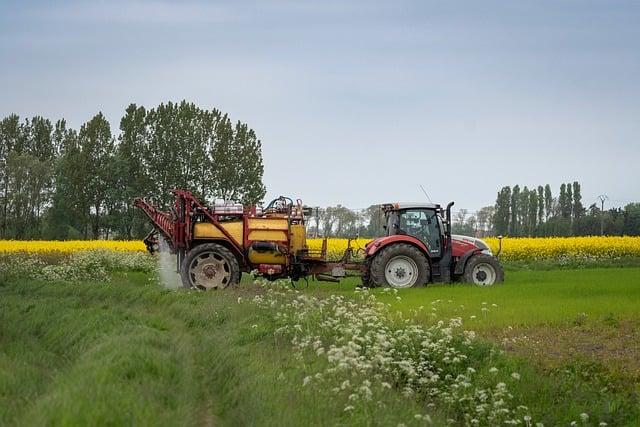As climate change escalates and atmospheric conditions evolve, the implications for agricultural productivity are becoming increasingly pronounced, particularly in vulnerable regions like East Africa. In Uganda, a country heavily reliant on its agricultural sector, recent research has revealed a troubling correlation between ozone pollution and the yield gap for bean crops—a staple food source and vital component of the national economy. This article delves into the findings outlined in a pivotal study published on Nature.com, which highlights how rising levels of ground-level ozone not only impair bean yields but also compound the effects of existing agricultural stresses such as drought, pests, and soil degradation. Understanding the interconnectedness of these environmental challenges is crucial for developing effective strategies to bolster food security and sustainably manage agricultural systems in Uganda and beyond.
Ozone Pollution’s Impact on Bean Yields in Uganda
Ozone pollution is emerging as a critical factor contributing to the agricultural yield gap, particularly for bean crops in Uganda. As a key staple in the region, beans play a vital role in food security and the local economy. However, studies have shown that elevated levels of ground-level ozone can considerably hinder photosynthesis and plant growth, leading to reduced yields. The impact of ozone is compounded by other agricultural stresses such as drought and pest infestations, creating a complex web of challenges that farmers must navigate. The interaction between ozone pollution and these stresses can exacerbate the vulnerabilities of bean crops, limiting their resilience and productivity.
The effects of ozone on beans can be observed through several physiological responses, such as leaf damage, stunted growth, and decreased seed quality. These changes not only effect the quantity of beans produced but also their nutritional value. Factors contributing to this pollution include industrial emissions, vehicle exhaust, and biomass burning, all of which are rampant in Uganda. The following table illustrates some of the key effects of ozone pollution on bean crops:
| Effect | Description |
|---|---|
| leaf Injury | Causes chlorosis and necrosis, reducing photosynthetic capacity. |
| Stunted Growth | Limits overall plant height and biomass accumulation. |
| Poor Seed Quality | Leads to lower germination rates and nutritional deficiencies. |
| Decreased Yield | results in a significant loss in overall production, impacting food security. |

Understanding the Co-Occurrence of Agricultural Stresses
The interaction of various environmental factors significantly impacts agricultural productivity, particularly for crops like beans in Uganda. Recent findings have identified ozone pollution as a crucial stressor that exacerbates yield gaps, directly influencing plant health and growth. However, ozone does not act alone; it frequently coincides with other stressors such as drought, nutrient deficiencies, and pests. this co-occurrence creates a complex web of challenges for farmers, making it essential to understand how these factors interrelate and compound their effects on crop yields.
To illustrate the multifaceted nature of agricultural stresses, the following table provides a snapshot of major stressors affecting bean production across diffrent regions in Uganda:
| Stress Factor | Description | Impact on Yield |
|---|---|---|
| Ozone Pollution | Harmful gas that inhibits plant photosynthesis. | Reduces overall plant health, leading to lower yields. |
| Drought | lack of adequate water supply during crucial growth phases. | Severely limits crop growth and development. |
| Nutrient Deficiencies | Insufficient levels of essential nutrients in soil. | Leads to poor plant vigor and diminished yields. |
| Pest Infestation | Invasion of crops by harmful insects or pathogens. | Causes direct damage to plants, further lowering yield potential. |
addressing these intertwined stressors requires integrated management approaches that enhance resilience in bean farming systems. by adopting lasting practices and utilizing climate-smart agriculture, farmers can mitigate the adverse effects of these agricultural stresses, paving the way for improved food security and livelihood sustainability in Uganda.

The Role of Environmental Factors in Crop Production
Ozone pollution poses a significant threat to crop production, particularly for beans in Uganda, where the delicate balance of agricultural ecosystems is already under pressure from various environmental stressors.This air pollutant not only reduces the photosynthetic efficiency of bean plants but also exacerbates the effects of other challenges such as drought, soil degradation, and pest infestations. The concurrent presence of these stressors can lead to a compounding yield gap, significantly impacting the livelihoods of local farmers and food security in the region. Understanding the intricate interplay between these environmental factors is crucial for developing effective agricultural strategies.
Mitigation efforts for crop production must focus on a multi-faceted approach, addressing both ozone levels and other agricultural stresses. Strategies may include:
- Improved agricultural practices: Implementing crop rotation and intercropping to enhance soil fertility and resilience.
- Adoption of resilient crop varieties: Utilizing genetically modified or hybrid beans that are resistant to adverse environmental conditions.
- Policy initiatives: Enforcing stricter emissions regulations to reduce overall air pollution.
Additionally, research indicates that farmer education on sustainable practices and environmental awareness can further bridge the yield gap caused by ozone pollution. A collaborative effort involving governments, NGOs, and the agricultural sector is essential for creating a robust framework that not only enhances bean production but also fosters a sustainable agricultural surroundings.

Strategies for Mitigating Ozone-Related Agricultural Challenges
Addressing the challenges posed by ozone pollution in Uganda’s bean cultivation requires a multi-faceted approach that incorporates sustainable agricultural practices and innovative technology. Implementing crop rotation with ozone-resistant varieties can help restore soil health and reduce susceptibility to air pollutants. Additionally, integrated pest management (IPM) can be enhanced to incorporate biological control methods, reducing reliance on chemical pesticides that may exacerbate plant stress under high ozone levels.Farmers should also prioritize agronomic practices,such as optimizing planting dates and adjusting irrigation schedules,to ensure crops receive adequate moisture and nutrients,helping them withstand ozone damage.
Collaboration between farmers, researchers, and governmental organizations is crucial for developing effective mitigation strategies. Establishing community training programs on ozone awareness and its impacts can empower local farmers with knowledge and resources. Furthermore, monitoring systems for ozone levels, combined with satellite data for climate and agricultural stressors, can provide real-time insights to farmers, enabling them to make informed decisions regarding crop management. In addition, fostering partnerships with universities and research institutions can accelerate the development of resilient bean varieties through genetic research, ensuring the long-term sustainability of bean production in the face of escalating environmental pressures.

Policy Recommendations for Enhancing Bean Yield Resilience
Addressing the yield gap for beans in Uganda necessitates a multifaceted approach. key policy recommendations include:
- Strengthening air Quality Regulations: Enhanced regulations to control ozone precursors, particularly from industrial and vehicular emissions, are essential.This coudl involve stricter limits on emissions and promoting cleaner technologies.
- Promoting Sustainable Agricultural Practices: Implementing agroecological practices that improve soil health and increase resilience to environmental stresses can significantly enhance bean productivity. These practices may include crop rotation, cover cropping, and organic fertilizers.
- Research and Development: Investment in research aimed at developing bean varieties resistant to ozone pollution and other abiotic stresses should be prioritized. Collaborative projects between government, universities, and NGOs could accelerate this process.
- Farmer Education and Support: Providing farmers with training on integrated pest management, soil conservation techniques, and adaptation strategies to cope with the impacts of both ozone and climate change is crucial for sustainable yield advancement.
The implementation of these recommendations should be tracked through a robust monitoring framework to assess their effectiveness. It is vital that all stakeholders, including government bodies, agricultural organizations, and local communities, work collaboratively to ensure the impact of these policies. A proposed framework for monitoring might include:
| Indicator | Measurement Tool | Frequency |
|---|---|---|
| Ozone levels | Air Quality Sensors | Monthly |
| bean Yield Per Hectare | Agricultural Surveys | Annually |
| Farmer Training Participation | Enrollment Records | Quarterly |
| Soil Health Metrics | Soil Testing Kits | Biannually |

Future Research Directions to Address Yield Gaps in Uganda
To effectively address the yield gaps for beans in Uganda, future research should focus on a multidisciplinary approach that integrates environmental, agronomic, and socio-economic dimensions. key directions include:
- Impact of Ozone Levels: Investigating long-term atmospheric data to quantify the effects of ozone pollution on bean yields and exploring potential adaptive strategies.
- Integrated Pest Management: Developing methods to mitigate stresses from pests that may be exacerbated by ozone, ensuring a holistic approach to crop health.
- Soil Health Improvement: Analyzing the interaction between ozone and soil conditions to enhance nutrient availability and plant resilience.
- Climate Adaptation Strategies: Implementing climate-resilient agricultural practices that consider the impacts of pollution on crop productivity.
Additionally,collaboration with local agricultural stakeholders is crucial for tailoring solutions to specific regional challenges. Future studies should prioritize:
- Community Engagement: Involving farmers in research initiatives to gather firsthand insights and foster adaptive practices.
- Data Sharing Platforms: establishing accessible databases that compile findings on ozone pollution’s effects and accomplished mitigation strategies.
- Policy Framework Development: Advocating for policies that address environmental pollutants while promoting sustainable agricultural practices.

Key Takeaways
the findings presented in this article underscore the urgent need for integrated strategies to address ozone pollution and its escalating impact on agricultural productivity in Uganda. As demonstrated, the interaction between ozone levels and other agricultural stresses such as drought and pest infestations is exacerbating the yield gap for bean crops, a staple food source crucial for food security in the region. Policymakers, researchers, and farmers must collaborate to implement effective mitigation measures and adaptive practices that can help preserve the integrity of Uganda’s agricultural systems. By prioritizing sustainable agricultural development and environmental health, there lies potential not only to enhance bean yields but also to foster greater resilience in the face of multiple stressors challenging the livelihoods of countless Ugandan farmers. As the climate continues to change, addressing the multifaceted issue of ozone pollution will be key to safeguarding the future of agriculture in East Africa.







